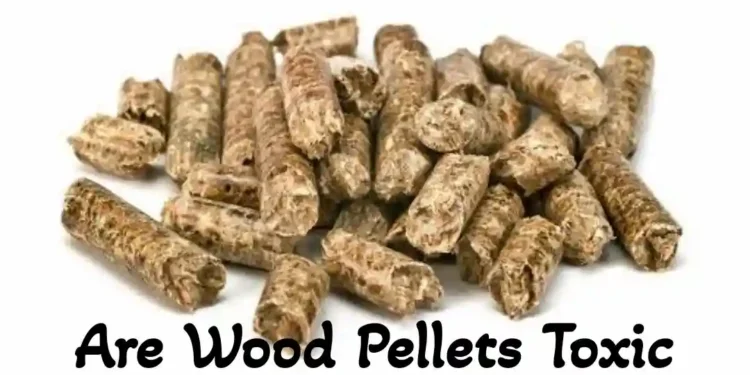Are Wood Pellets Toxic To Dogs? My Dog Ate Wood Pellets

With their compressed sawdust and wood byproducts composition, wood pellets are widely used as home heating sources and pet bedding. Yet, it is vital for responsible pet owners to be knowledgeable of potential hazards that may arise from household items like wood pellets. So, are wood pellets toxic to dogs?
This article will give a brief overview of wood pellets and dive into their toxicity risks for dogs. Having insights into the components, likely threats, and prevention measures surrounding wood pellets can aid you in making careful choices for your beloved pets’ safety.
Composition of wood pellets – Materials used in making wood pellets
As concerns for eco-friendliness and renewable resources continue to grow, wood pellets offer a solution. Made from sawdust and other wood byproducts sourced from mills, factories, and furniture manufacturing plants, these small cylinders are an ideal energy source. After grinding the materials into a fine consistency and pressing under high pressure, they provide efficient fuel. Let us take a deep look at the materials used in making wood pellets:
Sawdust
In the production of wood pellets, sawdust ranks high as the most frequently used raw material. Sawdust is a byproduct that derives from several activities performed on wood like cutting, grinding, drilling, and sanding. To prepare it for use in pellet production and ensure its quality consistency and purity standards must be met during processing.
Wood byproducts
The production of wood pellets involves using various kinds of wooden debris apart from sawdust. These include chippings, barks, and shavings generated in carpentry activities. The right quantity and mixtures of these wooden remains depend majorly on manufacturers’ discretion as they strive to achieve specific desired features for their products.
Binders and additives
To hold the wood particles together and improve the performance of the pellets, binders, and additives may be added during the production process
Natural lignin
During the creation of pellets from wood, lignin plays a significant role by acting as a binder when exposed to heat and pressure. As a result of this trait, synthetic additives are not always necessary as lignin allows for effective cohesion between wood particles. Nonetheless, some pellet manufacturers decide to include additional binders or additives to amplify specific features.
Potential for chemical additives
Using only natural binders is the norm for producing wood pellets. However, some manufacturers choose to add chemical additives to improve properties such as combustion efficiency and durability. These can range from starches to paraffin or other binding agents. But it is crucial to know what chemicals are added since certain ones could be harmful if ingested or inhaled by dogs.
Are Wood Pellets Toxic To Dogs?
When it comes to wood pellets and their interaction with dogs, toxicity is generally not a concern. However, mishandling and improper storage methods can create potential dangers that should not be ignored. Canines may experience allergic reactions or ingestion-related complications that carry consequences worth taking precautions against. The potential risks of wood pellets to dogs are as follows:
Ingestion
- Choking hazard
The small yet robust shape of wood pellets may lead to serious choking incidents in dogs, particularly those belonging to smaller breeds or young puppies. When these little cylinders get caught in the canine’s throat, they restrict airflow through the respiratory tract, resulting in life-threatening scenarios.
- Gastrointestinal obstruction
Blockages can occur within a dog’s gastrointestinal tract when exposed to large quantities of wood pellets; this creates a condition known as a gastrointestinal obstruction which hinders proper digestion and elimination functions. A host of distressing warning signs accompany this health problem; notable examples comprise episodes characterized by vomiting mutt chunks accompanied by the presence of genuine discomfort experienced in regions around their abdomen inducing listlessness and lack/loss/lackadaisical attitude toward eating anything at all during mealtimes.
Prompt veterinary care should be sought out upon identifying these concerning symptoms.
Toxicity
- Chemical additives
As mentioned earlier, manufacturers tend to add chemical supplements into wooden pellets for them to attain specific desirable attributes which at times turn out hazardous when consumed by dogs based on the category and concentration levels. Clinical features related to toxicity caused by these substances comprise shivering, convulsions or seizures; coughing or having trouble breathing; diarrhea or vomiting among others.
- Contaminants from the manufacturing process
While wood pellets are a popular choice for pet owners looking for sustainable and affordable products, it’s essential to be aware of any potential dangers they may pose. Despite the minimal likelihood of hazardous substances like pesticides and heavy metals remaining from production processes being present in small amounts – such exposure over time can still lead to adverse impacts on your furry friend.
Allergic reactions
For some four-legged friends, wood or wood-based products may cause sensitivity or allergy. If your furry companion comes into contact with wood pellets that are derived from a type of wood they’re adverse to, they might experience an allergic reaction. Indications of such an occurrence could consist of itching, redness, swelling, or respiratory concerns.
Tips for preventing exposure to wood pellets
To protect your canine companion from the potential hazards that wood pellets may pose, it is vital to establish preventative protocols. This will help eliminate instances of choking or allergic responses resulting from accidental ingestion. Nurturing a safe environment for your pet entails knowing the risks and taking action early on.
1. Proper storage
Don’t let something as simple as improper storage put your beloved pet at risk! Keep those pesky wood pellets under wraps by using a solid container fitted with an astronomical seal that reduces any chance of leakage or hazardous materials escaping into its surroundings. Remember too, where you choose to store such items plays just as large a role in safeguarding against them being ingested by accident – whether on purpose or not – so choose wisely!
2. Supervision around wood pellets
Being vigilant in monitoring dogs around wood pellets ultimately contributes to their overall health and safety. To avoid gravity-related accidents, ensure access points for pellet stoves or heaters are inaccessible to pets. Immediate cleanup of scattered bits can also prevent unintentional consumption.
3. Regular inspection of pellet storage areas
Regularly inspect the area where you store your wood pellets, checking for signs of spills, leaks, or damage to the storage container. Promptly address any issues to minimize the risk of your dog coming into contact with the pellets.
4. Choose high-quality wood pellets
When purchasing wood pellets, opt for high-quality, reputable brands with transparent ingredient lists. This will help you avoid products with potentially harmful additives or contaminants. If possible, select wood pellets made without any chemical additives to minimize the risk of toxicity.
5. Educate family members and visitors
To prevent any life-threatening accidents involving wood pellets, educating yourself along with all family members on possible risks must be given priority. Your beloved four-legged companion needs extra care as they may accidentally ingest or come into contact with these hazardous materials while playing indoors. It is advisable to brief guests on the actions taken by you against situations where things could go wrong.
My Dog Ate Wood Pellets – What to do if your dog is exposed to wood pellets
Despite taking precautions, accidents can still happen. If your dog comes into contact with or ingests wood pellets, it’s crucial to know how to respond appropriately to minimize any potential harm.
Monitoring for signs of distress
In case your canine has had exposure with wood pellets always make sure to take note of any distress symptoms they might display. Some indications include frequent coughing, gagging and even diarrhea. These signs are red flags and could point out that the dog ate the pellets intentionally or accidentally; it could as well imply some sort of hypersensitivity from allergic reactions. Alongside these symptomatic peculiarities, monitor their activities closely for lethargy or any other atypical behavior patterns.
Seeking veterinary care
In the event that your canine friend manifests any signs of unease after encountering wooden pellets or if you suspect that they have devoured a significant quantity of them, it is crucial to get in touch with your local veterinary services immediately. They possess enough expertise to provide advice on what should be done next- this might necessitate taking your pet animal for an examination and treatment.
Some instances warrant induced vomiting so that any ingested particles can be extracted; never try anything without clear guidelines given by an experienced vet professional because it may aggravate the situation.
At-home care and recovery
If your dog has experienced a mild reaction to wood pellets, such as itching or mild gastrointestinal upset, your veterinarian may advise at-home care and monitoring. This could include:
- Offering small amounts of water and bland food: If your dog has experienced mild gastrointestinal symptoms, provide small amounts of water and a bland diet to help soothe their stomach. A bland diet typically consists of boiled chicken or lean ground beef mixed with cooked white rice.
- Providing antihistamines: If your dog is experiencing an allergic reaction, your veterinarian may recommend administering an over-the-counter antihistamine, such as diphenhydramine (Benadryl), to alleviate itching and swelling. Always consult with your veterinarian for the appropriate dosage and follow their instructions closely.
- Monitoring for complications: Keep a close eye on your dog during their recovery, watching for any signs of complications, such as worsening symptoms or new issues arising. If you notice anything concerning, contact your veterinarian immediately.
- As part of nursing your furry pal back to health, you need to reintroduce their regular diet gradually. Allow plenty of time for the transition as sudden changes would aggravate any issues that they just recovered from.
When dealing with wood pellet exposure in dogs, there are measures you can take to prioritize their safety and health. Nonetheless, maintaining open communication with your veterinarian and following their guidance is crucial for optimal care for your furry friend.
Are wood pellets safe for puppies?
The sensitivity of the puppy’s stomach means that the wood pellets may trigger nausea, diarrhea, and other GI troubles. While large amounts would certainly block the puppy’s intestines.
So, wood pellets are not safe for puppies and your little pups should be kept far away since they may not be able to ascertain what is good for them or not.
Conclusion
The use of wood pellets as an alternative energy source has become increasingly popular among homeowners over recent years; however, it poses inherent risks for companion animals such as dogs who may come into contact with this substance daily.
Risks associated with wood pellet exposure include choking hazards and digestive blockages caused by consumption of the small-sized pieces commonly used in heating systems.
Additives found in some brands may also trigger allergic reactions or toxicity in pets who ingest it unintentionally; thus safe storage practices must be implemented and pets need adequate supervision during installation maintenance services within homes where they dwell.
Prompt veterinary attention should be sought out if you suspect your dog has ingested harmful amounts of this substance. As a conscientious pet parent, recognizing and mitigating potential dangers is crucial to guaranteeing your cherished canine’s safety. Taking the appropriate measures will help care for your dog’s health.






